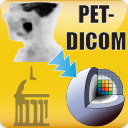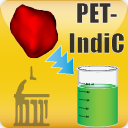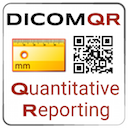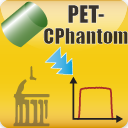Overview
To facilitate quantitative analysis of FDG PET scans in clinical trials, we have developed open source software (extensions) for 3D Slicer. This website provides an overview of available software, short introductory videos, and links to source code available on github.
 PET DICOM Extension
PET DICOM ExtensionThe PET DICOM Extension provides tools to import DICOM PET images into Slicer and performs Standardized Uptake Value (SUV) normalization. Specifically, it calculates Standardized Uptake Value (SUV) conversion factors and creates a corresponding Real World Value Mapping file.
Source code: https://github.com/QIICR/Slicer-PETDICOMExtension
Documentation: https://www.slicer.org/wiki/Documentation/Nightly/Extensions/PETDICOM
Version history: Available since Slicer 4.6.2.
Functionality verified up to Slicer 5.0.2.
 PET IndiC
PET IndiCThe PET-IndiC Extension enables calculating quantitative indices of PET tracer uptake from segmented structures in PET scans.
Source code: https://github.com/QIICR/Slicer-QuantitativeIndicesExt
Documentation: https://www.slicer.org/wiki/Documentation/Nightly/Extensions/PET-IndiC
Version history: Available since Slicer 4.6.2. - In Slicer 4.8.0, the "PET Segment Statistics" plugin was added. - In Slicer 5.0, the “PETIndiC” module was removed because the "Legacy Editor" it depended on was removed from 3D Slicer. Please use as GUI replacement the “Quantitative Reporting” module (see below).
Functionality verified up to Slicer 5.0.2.
This tool allows automated measurement of liver uptake in SUV normalized FDG-18 whole-body PET scans. A detailed description and evaluation of the method can be found in paper "Automated measurement of uptake in cerebellum, liver, and aortic arch in full-body FDG PET/CT scans", which was published in Medical Physics.
Source code: https://github.com/QIICR/PETLiverUptakeMeasurement
Documentation: https://www.slicer.org/wiki/Documentation/Nightly/Extensions/PETLiverUptakeMeasurement
Version history: Available since Slicer 4.6.2. - In Slicer 4.8.1, DICOM SEG and SR export were added.
Functionality verified up to Slicer 5.0.2.
This tool provides an Editor-Effect for semi-automated segmentation of tumors and hot lymph nodes in PET scans. A detailed description and evaluation of the method can be found in paper "Semiautomated Segmentation of Head and Neck Cancers in 18F-FDG PET Scans: A Just-Enough-Interaction Approach", which was published in Medical Physics.
Source code: https://github.com/QIICR/PETTumorSegmentation
Documentation: https://www.slicer.org/wiki/Documentation/Nightly/Extensions/PETTumorSegmentation
Version history: Available since Slicer 4.6.2. - In Slicer 4.8.0, the "Segment Editor Effect" was added. - In Slicer 4.10.1 and 4.10.2 on MS Window, the extension is not working properly. - Since Slicer 4.11.20200930, only the "Segment Editor Effect" is working correctly. - In Slicer 5.0, the "Legacy Editor" was removed from 3D Slicer. Please use the "Segment Editor Effect" instead.
Functionality verified up to Slicer 5.0.2.
 Quantitative PET Image Analysis using DICOM Standard
Quantitative PET Image Analysis using DICOM StandardThe suite of Iowa PET analysis tools can be used in combination with the QIICR Quantitative Reporting extension to analyze tumors in PET scans and export results as DICOM SEG and SR files. A detailed description explaining the involved DICOM SEG and SR's can be found in the paper "DICOM for quantitative imaging biomarker development: a standards based approach to sharing clinical data and structured PET/CT analysis results in head and neck cancer research." [https://doi.org/10.7717/peerj.2057]
Quantitative Reporting source code: https://github.com/QIICR/QuantitativeReporting
Quantitative Reporting Documentation: https://qiicr.gitbooks.io/quantitativereporting-guide/content
Version history: Available since Slicer 4.10.0.
Functionality verified up to Slicer 5.0.2.
 PET Cylinder Phantom Analysis
PET Cylinder Phantom AnalysisThe PET Phantom Analysis Extension enables automated analysis of Uniform Cylinder Phantoms in PET scans utilized for quality control purposes.
Source code: https://github.com/QIICR/SlicerPETPhantomAnalysis
Documentation: https://www.slicer.org/wiki/Documentation/Nightly/Extensions/PETPhantomAnalysis
Version history: Available since Slicer 4.10.0.
Functionality verified up to Slicer 5.0.2.
Acknowledgements
This work was supported in part by NIH NCI QIN project grant U01 CA140206 as well as the Quantitative Image Informatics for Cancer Research (QIICR) project (U24 CA180918).

Contact
The contents of this website does not necessarily represent the official views of the NIH/NCI.
